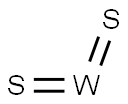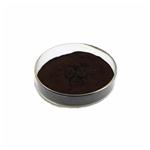Description
Tungsten sulfide (S2W) is a chemical compound that exists naturally in the form of a rare mineral called tungstenite. It is used as a principal component of catalysts in processes such as hydrogenation of crude oil, hydrodesulfurization and hydrodenitrification reactions. It is widely employed as additives in solid lubricants to improve lubricants and extreme pressure properties and antiwear properties especially in environments of high temperature, high pressure, high vacuum, high load and with radiation and corrosive media. Due to the above property, the nanoscale of tungsten sulfide can be also added in the casting process which helps make cast metal have a certain self-lubricating properties and have an excellent adsorption capacity on the metal surface. It can also be used as solid-state secondary lithium battery cathodes and other electrochemical devices. Besides, it is found that the friction coefficient of tungsten sulfide is relatively small, which makes it an additive in other metal powder for a stable friction coefficient. It also finds application in semiconductor materials, inorganic nanotubes, etc.
Uses
Tungsten disulfide (WS2) in bulk has been used for many years as a dry lubricant due to how it exhibits properties of a low coefficient of friction, high chemical stability, and thermal stability. In 1992, it was discovered that the structure of WS2 made it capable of forming nanotube structures. These nanotubes were the first examples of WS2 being used as a low-dimensional material.
After the discovery of simple mechanical exfoliation techniques to isolate single layers of 2-D materials, it was possible to study the properties of WS2 flakes. It was shown that, just like MoS2, the band-gap of WS2 change from an indirect band-gap of 1.4eV to a direct band-gap of 2eV when changing from a bulk material to a 2-D material. Due to its band-gap, WS2 is seen as a significantly interesting material for many areas of application.
WS2 possesses a high on/off ratio in field-effect transistors, controllable spin and valley polarisation, strong geometrical confinement of excitons, and tunable photoluminescence. Additionally, WS2 could lead to increased interest in areas such as photodetectors and multi-junction photovoltaics.
Besides, WS2 is used, in conjunction with other materials, as catalyst for hydrotreating of crude oil.
Lamellar tungsten disulfide is used as a dry lubricant for fasteners, bearings, and molds under the brand name Dicronite.
References
https://en.wikipedia.org/wiki/Tungsten_disulfide
https://www.alfa.com/zh-cn/catalog/011829/
http://www.us-nano.com/inc/sdetail/1030
http://www.azonano.com/article.aspx?ArticleID=3360
Description
Few-layer?tungsten disulfide (WS2) film has a 2D-layered structure with a narrow indirect bandgap of of 1.35 eV. In contrast, the monolayer film possesses a direct bandgap of 2.1 eV.
Preparation
Synthetic?- Chemical Vapour Transport (CVT)
Application
Due to its distinctive electron configuration and high specific surface area, few-layer tungsten disulfide nanosheets have potential applications in electrodes and energy storage devices, supercapacitors, and photoelectrochemical cells as a catalyst for hydrogen evolution reactions (HERs). With?tunable electromagnetic absorption, it has practical applications?against electromagnetic pollution. WS2?is also a great potential candidate in photothermal therapy for the ablation of cancer cells, when NIR light is absorbed and converted into heat.
Synthesis
High-quality tungsten disulfide monolayer?films?are grown directly on the substrates (sapphire) by? the chemical vapour deposition (CVD) method.
Chemical Properties
Grayish-black solid. Mp above 1480C,
can lubricate at temperatures above 2400F (1316C).
Attacked by fluorine and hot sulfuric and hydrogen
fluoride.
Uses
Tungsten sulfide is used as a component of catalysts for hydrotreating of crude oil, hydrodesulfurization and hydrodenitrification reactions. It finds application as solid-state secondary lithium battery cathodes and other electrochemical devices. It is found that it forms inorganic nanotubes, which is better reinforcing agents than carbon nanotubes. Tungsten sulfide addition to epoxy resin improves adhesion, fracture toughness and strain energy release rate.
Uses
Tungsten sulfide possesses a pseudo 2 dimensional structure with applications in the Petrochemical industry as a desulfurization catalyst. Tungsten Sulfide nanoparticles have drawn research interest due to their potential in solid-state lubricants; coatings and photocatalysts.
Uses
Tungsten disulfide (WS2) is used as a solid lubricant that can withstand high temperatures.
It is also used as a spray lubricant.
Definition
ChEBI: Tungsten disulfide is a sulfide salt.
Flammability and Explosibility
Not classified
reaction suitability
reagent type: catalyst
core: tungsten




